Ryan Hall's Blog, page 155
June 26, 2017
Oldest Half Marathon Finisher Harriette Thompson Appears on Good Day Charlotte
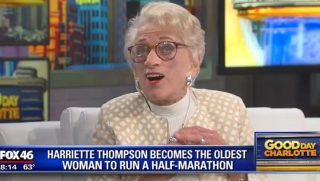
This morning, Harriette Thompson, who is the world’s oldest finisher in both the marathon and (more recently) the half marathon, made a guest appearance on North Carolina’s TV program Good Day Charlotte. The 94-year-old Charlotte local had run the Synchrony Financial Rock ‘n’ Roll San Diego Half Marathon back in June and made history as the oldest half marathon finisher, completing the race in 3 hours, 42 minutes and 56 seconds. She’s also on Competitor magazine’s July cover, in which the hosts of Good Day Charlotte surprised her with a first-time reveal. When asked on the show if her ego has swelled due to all the attention she’s been getting, though, Thompson replied with a joke, “I didn’t realize it but I was getting so many compliments in San Diego that my head got REALLY big,” as she raised a giant cardboard cutout of her head.
The post Oldest Half Marathon Finisher Harriette Thompson Appears on Good Day Charlotte appeared first on Competitor.com.
Coburn and Jager Dominate in Steeplechase with Sixth Consecutive Titles
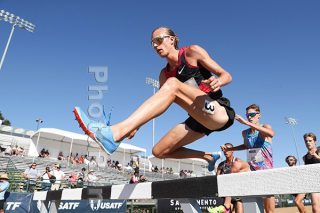
Photo: Photorun.net
(c) 2017 Race Results Weekly, all rights reserved
The women’s steeplechase victory went to Emma Coburn of Team New Balance winning her sixth consecutive title at the USATF Outdoor Championships with little drama in 9:20.28, her slowest winning time since 2013.
Coburn, the 2016 Rio Olympic bronze medalist, ran from the front, slowly ramping up the pace, and gently pulling away from her 2016 Olympic teammates, Courtney Frerichs and Colleen Quigley of the Nike Bowerman Track Club. Frerichs and Quigley finished second and third, respectively, in 9:22.23 and 9:25.40. All three women ran well under the 9:42.00 IAAF qualifying time.
“You know, the U.S. Championships are always so important, and as the years go on there’s kind of a double-edged sword where I feel more comfortable and more confident,” Coburn said. “At the same time, I have more to lose because I want to keep my streak going, and the women’s steeple is getting more and more competitive.”
In the men’s steeplechase race yesterday, Evan Jager of the Nike Bowerman Track Club ran patiently, took control of the race with a lap to go, began to pull away from the field on the backstretch, then shot decisively ahead through the final water jump to clinch his sixth straight USA title in 8:16.88.
“I knew it was going to be hard,” Jager said. “It was a little windy, so I didn’t want to be out in the lead for four and a half laps like last year. So, I wanted to wait and kind of trusted my speed and my hurdling form, my technique, against the rest of the guys.”
Two former Kenyans, Stanley Kebenei (Nike/American Distance Project) and Hillary Bor (U.S. Army), desperately tried to catch Jager in the homestretch and took second and third, respectively, in 8:18.54 and 8:18.83. Andy Bayer, Jager’s former teammate at the Bowerman Track Club, ran an excellent 8:18.90, but finished fourth for the third consecutive time at these championships, and the fourth in five years.
RELATED: Robby Andrews Nabs First USA Championships 1500-Meter Title
The post Coburn and Jager Dominate in Steeplechase with Sixth Consecutive Titles appeared first on Competitor.com.
Robby Andrews Nabs First USA Championships 1500-Meter Title
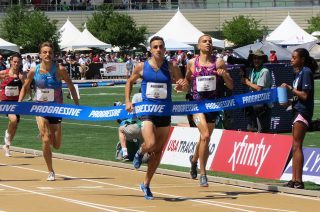
Andrews wins the 2017 USATF Outdoor Track & Fiend Championships 1500m over Matthew Centrowitz (2nd place, right). Photo: David Monti
(c) 2017 Race Results Weekly, all rights reserved
With mid-afternoon temperatures hovering at about 100°F inside of Hornet Stadium, Robby Andrews kept his cool in the men’s 1500-meter final at the USATF National Outdoor Track & Field Championships in Sacramento, Calif. Timing his final sprint to perfection, the 26-year-old Olympian picked up his first national outdoor title and locked in a provisional team berth for the IAAF World Championships in Athletics in London in August.
“It feels really good to (finally) win a race,” a smiling Andrews told the media.
Andrews, who represents adidas, finished second at last year’s Olympic Trials in the same discipline, behind eventual Olympic champion, Matthew Centrowitz of the Nike Oregon Project. But Centrowitz had been struggling recently to overcome several health problems before these championships and revealed that after a period of light cross-training he had only been running for ten days.
Nonetheless, Centrowitz was the race leader as the 13-athlete field ran through the finish line for the first time, but the pace was predictably slow. Clayton Murphy of Nike, the 2016 Olympic 800m bronze medalist, was tucked into the pack while Andrews was at the back with another podium contender, Ben Blankenship of Nike Oregon Track Club Elite, who would make the most important move of the race, surging hard at the bell.
“I really thought with the heat and everything I would be able to close well,” Blankenship told the media.
Centrowitz immediately followed, and the two Oregon-based athletes charged down the backstretch while the rest of the field scrambled to catch up. Andrews, who was in fifth position at the bell, thought about the conversations he had with his coach, Jason Vigilante, prior to the race and knew what to do.
“I was expecting Matt, Cristian (Soratos) or someone else to take it pretty far out, and they did that. I just tucked in, stayed as patient as I could.”
Blankenship would struggle in the final 200 meters, and eventually faded to 12th at the line. Murphy, who was later seen limping off the track then driven away in a golf cart, also faltered and finished last (he has the 800m final tomorrow). But Andrews got stronger as the last lap wore on, and was charging hard. He had no idea if he could win it, but he was all-in.
“Matthew’s the Olympic champion; I’m not going to take anything for granted,” Andrews said. “At one point I was racing for third, and then I was like, ‘Oh, I can get ’em, I’ll go for second.’ And then I’m, like, I can win this thing!”
Barreling down lane two, Andrews got to the tape a step ahead of Centrowitz on the strength of a 52.23-second final lap, 3:43.29 to 3:43.41. Behind the two Olympians, Johnny Gregorek out-leaned recent Ole Miss grad Craig Engels, by 2/100ths of a second in 3:43.99, making his first world team. Soratos finished fifth.
“Today, third is as good as first,” said Centrowitz who was happy to make his sixth consecutive national team for an outdoor global championships. “But, also disappointed that I couldn’t win it.”
Centrowitz and Gregorek both have the relevant IAAF qualifying standard of 3:36.00 (or 3:53.40 for the mile), while Andrews doesn’t. He has until midnight, July 21, to get it.
“I’m going to try to get the standard as quick as I can, and represent the country at London,” said Andrews.
RELATED: A Quick Recap of Day One at the USATF Outdoor Championships
The post Robby Andrews Nabs First USA Championships 1500-Meter Title appeared first on Competitor.com.
June 23, 2017
Read the July 2017 Digital Edition of Competitor Magazine
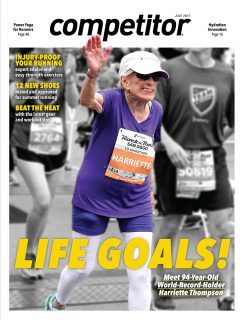
Flip through our July edition, which features 94-year-old world-record-holder Harriette Thompson—who became the oldest half marathon finisher ever—on our cover. Also in this issue, learn how to injury-proof your running with expert advice and easy strength exercises for runners, check out 12 new road shoes out this summer, and beat the heat with the latest gear and workout tips for optimal summer running.
Find our print edition at a location near you with the store locator.
The post Read the July 2017 Digital Edition of Competitor Magazine appeared first on Competitor.com.
See What It’s Like To Race In Mammoth Where The Pros Train
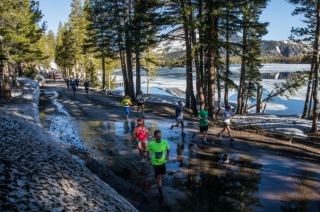
Photo: Christian Pondella
Mammoth Lakes, Calif., is a mecca for runners, from the Mammoth Track Club’s record of producing some of the top record-holders in various distances and Olympic marathoners like Deena Kastor and Meb Keflezighi regularly running in the winding trails at altitude to prepare for some of their biggest performances.
If you’ve ever wanted to run in the majestic beauty of Mammoth but couldn’t take a week away for a training camp, the Mammoth Half Marathon is the perfect way to see what running in the town is all about.
Get a firsthand look at this year’s race that took place last weekend in the video above, featuring Mammoth-local Tim Tollefson—who was the overall winner—and his wife Lindsay, who finished third overall and was the first woman to cross the finish line.
RELATED: 25 Fun Half Marathons You’ll Want to Run This Year
The post See What It’s Like To Race In Mammoth Where The Pros Train appeared first on Competitor.com.
Watch The Emotional Trailer For The New Boston Marathon Bombing Biopic

The first trailer for the movie Stronger was released today. The film stars Jake Gyllenhaal as Boston Marathon bombing survivor Jeff Bauman. Based off his autobiography, the movie follows Bauman’s recovery after losing both of his legs while waiting for his girlfriend (played by Tatiana Maslany) at the end of the 2013 race. The emotional trailer follows how Bauman transitioned to his new life, first with difficulty, but ultimately accepting his status as an inspirational figure.
Watch the trailer above. Stronger opens in theaters on Sept. 22, 2017.
RELATED: Why The Boston Marathon Is So Special
The post Watch The Emotional Trailer For The New Boston Marathon Bombing Biopic appeared first on Competitor.com.
Nick Symmonds Retires At The USATF Outdoor Championships
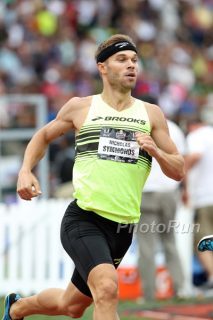
Photo: Photorun.net
Yesterday, after finishing seventh in the first heat of 800-meters at the USA Track & Field Outdoor Championships, Nick Symmonds officially retired.
Earlier this year he said it would be his final season on the track and he went into yesterday’s race hoping to take it all. Things didn’t quite work out that way, but Symmonds seemed to come to terms with it, sharing his thoughts after the race with The Oregonian:
“You know what? I left everything I have on the track,” Symmonds said. “I feel like I did myself justice. All you can do is play the cards you’re dealt. I’m a short, stocky kid from Boise, Idaho, who went to a Division III school, and ended up being ranked No. 3 in the world.”
Symmonds is a two-time Olympian who trains with Brooks Beasts Track Club (previously he ran with Nike). He gained additional notoriety for his outspoken nature regarding doping in the sport and has been an advocate for running clean.
This isn’t the end for him in terms of running. Symmonds has announced he will travel to Hawaii to run in the Honolulu Marathon in December.
“It was all about saying goodbye to everybody; I gave everyone a hug I could find today,” Symmonds told Race Results Weekly. “I’ve got one more race in my legs. I’m here to let you guys know that the last race I’ll run as a pro is the 2017 Honolulu Marathon on Dec. 10.”
RELATED: A Quick Recap of Day One at the USATF Outdoor Championships
The post Nick Symmonds Retires At The USATF Outdoor Championships appeared first on Competitor.com.
A Quick Recap of Day One at the USATF Outdoor Championships
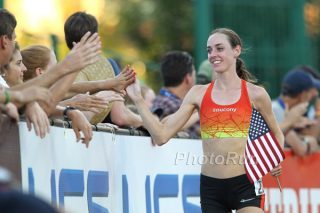
Molly Huddle continues her championships winning streak in the 10,000m for a third year after her first win in 2015. Photo: Photorun.net
(c) 2017 Race Results Weekly, all rights reserved
Galen Rupp’s streak of eight consecutive USA 10,000m titles came to an end last night at Hornet Stadium in Sacramento, Calif., when the two-time Olympic medalist faded in the final lap of a choppy and slow race, which was won by Oregon Track Club Elite’s Hassan Mead in 29:01.44. Rupp, who runs for the Nike Oregon Project, finished fifth. On the women’s side, Saucony’s Molly Huddle extended her winning streak at these championships to three, comfortably winning the 25-lap race in a solid 31:19.86, the second-fastest by an American this year.
RELATED: 5 Things To Watch At The USATF Outdoor Championships
Men’s Race Became a Cat and Mouse Affair
While the women’s contest was a traditional battle of endurance won off of a steady and strong pace, the men’s race early on became a game of cat and mouse. Feeling no pressure to run a fast time, the men’s pack jogged through the first 800 meters in 2:29, only slightly faster than the women (2:32). The group of 24 athletes was tightly bunched, with veteran Ben Bruce of Hoka Northern Arizona Elite at the front.
With 19 laps to go, 2015 national road running champion Sam Chelanga became impatient. Coming down the homestretch, he shot to the lead and threw in a 64.7-second lap, followed by another at 65.1. Rupp covered the move, making sure that Chelanga stayed within reach, and it looked like the race was simply getting more serious.
“We were just jogging,” Chelanga told the media after the race. “I figured, these people (the fans) didn’t come to just watch us jog… (so) I took it out.”
But then lap after lap, Chelanga allowed the field to catch up, then he sprinted away again down the homestretch, each time opening up a three to four-second gap on the field. The 32-year-old Nike-sponsored athlete looked like he was doing a fartlek workout.
Behind Chelanga, Rupp was running with the race’s other favorites: Mead, Nike Bowerman Track Club’s Chris Derrick, U.S. Army’s Shadrack Kipchirchir and Leonard Korir, American Distance Project’s Biya Simbassa, and Asics’s Diego Estrada. Mead knew how strong Chelanga was, but he wasn’t going to let his tactics sway him.
“Sam’s strong; you’ve got to respect Sam,” Mead told the media. “Just being in this sport and this event, it’s hard for him to do that solo.”
Each time the group passed the finish line, the yo-yoing Chelanga was still in the lead until there were three laps to go. Then Rupp surged to the front, dropping Chelanga (who would later finish seventh). Derrick made a strong move on the backstretch which turned into a 62-second penultimate lap. Rupp was at the back of the group and would never recover his position.
Mead—who dropped out in this discipline with less than 400 meters to go at last year’s Olympic Trials—felt confident with his speed. His legs were still fresh and he could smell victory.
“For me, the slower they went the better,” Mead admitted. “If you ask me personally, I think I have great confidence in myself that I had the best kick in the group. So, if you want 33 minutes and it came down to the last K, I was ready to run 2:22.”
Mead ripped the last lap in 55.3 seconds, and that was just enough to beat Kipchirchir, who clocked 29:01.68. Korir, who made last year’s Olympic team in the same discipline, finished third in 29:02.64, and Simbassa was fourth (29:03.48). Derrick, who has battled injuries the last two seasons, finished eighth.
“It was a strange race,” Derrick told reporters.
A visibly upset Rupp did not speak with the media, despite pleas from USA Track & Field officials to stop in the mixed zone.
Huddle Rides Express Train to Victory
By comparison, Huddle’s race seemed almost scripted. Running in her first USA Championships 10,000m since 2015, Olympic silver medalist and Nike Bowerman Track Club athlete Shalane Flanagan went immediately to the front and set an honest pace. After a 78.7-second opening circuit, the 2:21 marathoner got right down to business with a 73.7-second second lap, immediately stringing out the field. Flanagan thought this was her best strategy.
“I don’t have a kick,” explained Flanagan who is short on training after suffering a fracture in her spine earlier this year. She continued, “I just looked strategically on paper, if I can go run 31:15 to 31:30 I had a chance.”
Huddle tucked in right behind Flanagan, and Huddle’s training partner, Team New Balance’s Emily Sisson, also fell into line along with Flanagan’s Bowerman teammate Emily Infeld. Behind the leading quartet, two more Team New Balance athletes, Natosha Rogers and Kim Conley, followed.
Lap after lap, Flanagan led, the athletes frozen in their places. For 20 laps, the 35-year-old was on the front, only sharing the lead with Huddle for four of those laps. The pace had slowed to 76’s and 77’s, but Huddle remained patient, confident that she could break away when the time was right.
“That’s what we were hoping for,” Huddle said of the steady pace. “The goal, obviously, for me and Emily to both make the team. She’s really strong, so we wanted it to be strung out. Shalane and Emily Infeld wanted the same thing.”
Huddle chose the penultimate lap to break away, running 69.6 seconds. She put the race away with a 65-flat final lap, thus booking her team spot for her sixth consecutive global championships.
“It was a rough last lap, but I just wanted to pour it all out,” Huddle said. “Whatever it was, it was good hard practice for Worlds.”
When the pace picked up on the final circuit, Flanagan was not able to jump to the next gear. That left the two Emily’s to battle for the second spot, with Infeld having the edge over Sisson, 31:22.67 to 31:25.64. Flanagan, who later said she had “big aspirations for the fall,” took fourth in 31:31.12.
“I haven’t been on the track in a while, and they just have those gears,” Flanagan said of her rivals tonight. “I was massively under-prepared, but was hoping that all of my strength from the 12 to 13 years would come into play, just being tough, just being gritty out there.”
Coburn Leads Steeplechase Qualifying
Five-time national women’s steeplechase champion Emma Coburn was the fastest tonight of 14 women who made Saturday’s final, clocking a comfortable 9:38.68 in the first heat. Her 2016 Olympic teammates, Colleen Quigley (9:40.63) and Courtney Frerichs (9:47.75) also advanced without incident.
“It was good,” said Coburn who runs for Team New Balance. “I was happy to not lead and just chill behind Megan (Rolland) for a while. Then with about 800 (to go), I just wanted to open my legs just a little bit so Saturday’s race wouldn’t feel quite as shocking. It was a good race.”
Stephanie Garcia, who has a 9:19.48 personal best, looked shaky in her prelim, stutter-stepping before several barriers and even falling on the second to last water jump. She recovered to finish fourth in the second heat in 9:48.70, and advanced to the final.
“Coming back after last year’s Olympic Trials really made me feel vulnerable,” said Garcia, who struggled the last 200 meters, fell over the final barrier and finished fifth. “You know, to put it out there then to have that ending. So, I’m proud of myself for coming back. I’m the fittest I’ve ever been.”
RELATED: Olympian Emma Coburn Is Aiming For Sixth USA Steeplechase Title
Favorites Advance Out of 1500-Meter First Round
There were few surprises in the first round of the men’s and women’s 1500m, with Olympic medalists Matthew Centrowitz, Clayton Murphy and Jenny Simpson all advancing with little drama.
Centrowitz and Murphy (who is doubling here in the 800 and 1500-meters), had the advantage of running in the third of three heats. Centrowitz, who runs for the Nike Oregon Project, made sure the pace was fast enough and didn’t mind finishing third in 3:40.79 behind Oregon’s Samuel Prakel (3:40.76) and Asics’s Johnny Gregorek (3:40.78). Murphy got fourth and advanced on time (3:40.94).
“I’m glad our heat went faster than the other ones, not so much because we got the auto qualifiers but more so (because) I put a hard effort in,” Centrowitz told reporters. “We have a day of rest, so not too worried about getting in a good hard effort in today; plenty of time to recover and get ready for the final.”
Also advancing on the men’s side was rising star Cristian Soratos. Coming off of a strong indoor season, the adidas athlete won the second heat over Olympian Robby Andrews, 3:42.01 to 3:42.25, with a confident kick.
“I had a couple of shaky races leading into this, but I knew it had nothing to do with my fitness,” said Soratos. “I knew if I executed properly today I could run well and get through.”
Simpson, a Team New Balance athlete, chose to lead her heat from gun to tape, a practical choice to avoid trouble, but also a decision to help the five collegiate athletes who were in her heat.
“I knew I was in a race with Sara Vaughn, who I know, and a lot of collegians,” Simpson told reporters. “And I thought, they’d probably like it if I took it, so I’ll just do it. It seemed like the easiest thing to do on a night like tonight.”
Other favorites headed to Saturday’s final were Nike’s Kate Grace and Alexa Efraimson, who finished one-two in the first heat; Oregon outgoing freshman Katie Rainsberger; and American record holder Shannon Rowbury of the Nike Oregon Project.
The post A Quick Recap of Day One at the USATF Outdoor Championships appeared first on Competitor.com.
June 22, 2017
Do This Sprint Workout To Build Up Your Leg Speed
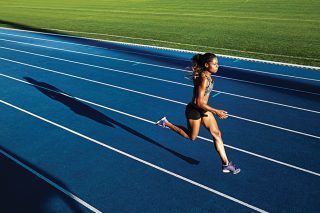
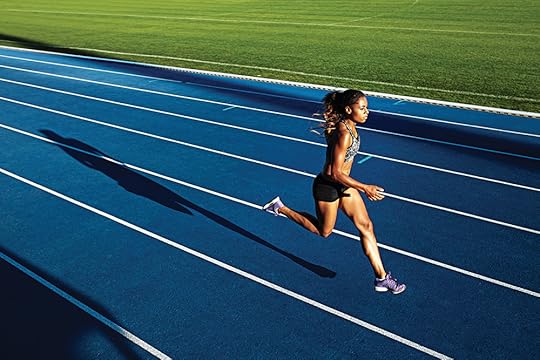
No sport benefits from leg speed like running does. Regular leg speedwork not only improves your basic speed but also actively stretches muscles and tendons in a specific manner, which means in the long term you’re much less likely to sustain running injuries. But it gets better: Leg speedwork can also improve your basic ability!
Think about it: If you can improve your stride length by 2 centimeters (approximately 16 meters per mile) and your cadence by two strides per minute (approximately 23 meters per mile), a runner with a 10K personal best of 40 minutes could improve by close to a minute. That can be achieved not by training harder, but simply by implementing leg speedwork.
If this sounds like you—and why wouldn’t it?— then use this workout to pick up more leg speed.
RELATED: Speed Workouts You Can Do Anywhere
The Workout
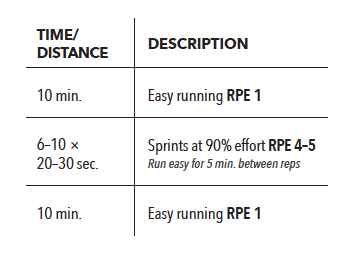
Rate of Perceived Exertion Scale
Scale—Effort—Race Pace
RPE 1—Easy—Slower than normal training pace
RPE 2—Moderate—Normal training pace
RPE 3—Moderately—Hard Marathon pace
RPE 4—Hard—10K race pace
RPE 5—Very Hard—5K race pace and faster
These sprints can be 20–30 seconds across a park, or they can be 100–200 m on a running track. They are fast, but not 100 percent, about the pace you would race 400 m. But this is not an effort session; it’s a technique session. You will huff and puff a bit at the end of each sprint, but the 5 minutes of easy running between reps should help you to recover fully so you can get through the session without undue effort. This is crucial because any fatigue will undermine your ability to run fast with good technique. To promote speed without undue effort, this workout is best done with a tailwind or on a slight downhill. It’s the kind of workout you can do year-round because as well as building leg speed and helping avoid injury, it’s a great final speed workout in the five days before a race and for maintaining speed between races.
RELATED: This Speed Session Will Help You Run Fast and Relaxed
How Fast Is Too Fast?
There is a fine line between a leg speed workout and an anaerobic workout. To avoid a crossover you need to do this workout just under maximum sprint speed and with 5 minutes between each sprint. Ideally the pace is around the speed you would race a 400m sprint. You could establish this pace by doing a 400m time trial or use the following table to estimate legspeed pace per 100m based on your 5K personal best.
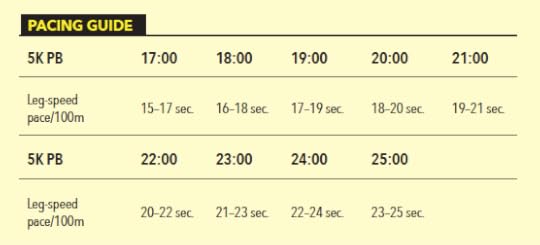
Excerpted with permission from One Hour Workouts: 50 Swim, Bike & Run Workouts for Busy Athletes by Scott Molina, Mark Newton and Michael Jacques (VeloPress, 2010).
The post Do This Sprint Workout To Build Up Your Leg Speed appeared first on Competitor.com.
How Well Does Running Fitness Translate To Other Sports?
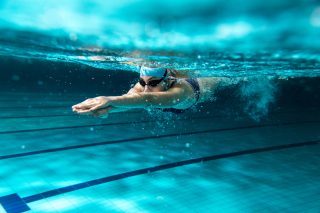
One of the claims of CrossFit Endurance is that runners can improve their long-distance race times while reducing their weekly mileage. The theory, according to CrossFit, is that by increasing muscle mass through powerful, explosive movement, you’ll have the strength for the long haul.
Right or wrong, CrossFit is onto one thing. By working some of the muscle groups you might not otherwise in running alone, you stand to make improvements.
Runners, while incredibly fit from a cardiovascular standpoint, tend to have several common weak spots: hip and glute strength, balance and upper body strength. One reason is that running only works one plane of movement. Lateral movement—which comes more from sports like tennis, soccer, lacrosse and even football—is missing in running. And so too is the ability to activate some of these related muscles.
It pays for runners to engage in other sports that do work these movement patterns and muscles. Aiming for better all-around fitness can help a runner perform better and avoid injury.
How does running translate to other sports?
It depends. Running is one of the best activities for overall cardiovascular fitness and raising an athlete’s VO2 max. Running is an ideal exercise to mix with sports like basketball, tennis and even cycling, where a big cardiovascular machine means that athletes can hang longer and often faster.
Interestingly, sports that also involve upright, weight-bearing movement are your best bets for enhancing running, and vice versa. So while swimming is one heck of a great cardiovascular workout , it won’t help you much as a runner. Rowing and cycling also won’t provide much benefit. Running, however, can help those sports, which is one reason you’ll often see these athletes using running for training.
The bottom line: Runners can become fitter and a better all-around athlete with a variety of sports and activities. Athletes from other sports can also improve their game by making running a part of the regimen.
RELATED: Why Runners Should Embrace Cross Training?
The post How Well Does Running Fitness Translate To Other Sports? appeared first on Competitor.com.
Ryan Hall's Blog
- Ryan Hall's profile
- 21 followers



